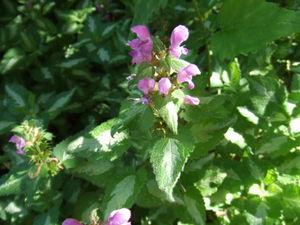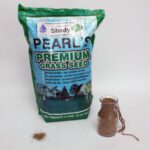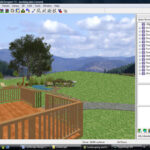Perennial ground covers can be the perfect solution for those areas under shade trees where grass is elusive and patches of soil is only appealing to youngsters after it rains. Those landscaping problems are fairly common and the remedy is not difficult. Those barren lawn areas are usually filled with ivy if anything at all. There are so many more perennial ground covers to choose from for those shady areas.
English ivy is attractive but it can just get a little mundane and very aggressive. Consider some of the perennial ground covers that will tolerate shade and add color at the same time. The color is often from beautiful foliage but it can also be from flowers. There are several varieties of perennial ground covers that bloom in the shade as an added bonus. Consider mixing ground covers with other shade perennials such as hostas and ferns. There are also variances of shade as well, so keep this in mind when choosing the ground covers and the location.
Determine your shade type
Study the area several times throughout the day. This will give a good indication of how much light it receives. Shade can also vary from season to season due to the change in the sun and the tree canopy. If the sun is blocked by trees with small leaves, then the shade is probably considered filtered or dappled sunlight. This type of shade will receive various amounts of bright light and shade during the day. It’s suitable for many perennial ground covers, including those that bloom.
The next type of shade is from a house or structure usually on the east or west sides of the house. It can also occur at the edge of a group of trees. These situations indicate that the perennial will receive four to six hours of sun a day and the remainder of the time be in the shade. This is considered partial shade and a large variety of plants can grow in this situation.
Areas that receive no direct sunlight at all during the day are considered low-light conditions. This is the most difficult type of shade for any plant to grow in. This shade will occur under the dense canopy of large maples, oaks, spruces, pines and other trees. In these conditions, there will not be any dappled sunlight. The plants will need to tolerate full shade.
These ten ground covers are just a small sampling of the vast array available to suit different needs and planting conditions. Any groundcover can eventually creep where it’s not welcome if it has the ideal growing conditions. It’s always best to check with a local nursery to see if a ground cover is considered invasive for your region.
10 Ground Covers for Shade
Bugleweed (Ajuga): This perennial ground cover has leaves that will grow into masses of foliage in green, variegated or bronze leaves. It blooms in the late spring through early summer with violet-blue flowers on 4 to 6 inch spires. The foliage is a fast-growing evergreen that reaches only 3 to 4 inches tall. It can be prevented from creeping into the lawn with an edge of stones or some other barrier. Zones 3 to 9.
Bearberry (Arctostaphylos): This perennial is great for sandy and rocky soils. The leaves are green with a tinge of gray. It’s a hardy low-growing evergreen ground cover that tolerates drought conditions. Bearberry does fine in the shade but near the coast it can tolerate sun. It’s not particular about soil, but does need good drainage. This ground cover adds pink or white flowers in the spring and red berries in the fall for the birds. Zones 2 to 8. (see photo. 4 )
Dwarf Mondo Grass (Ophiopogon japonicus): This petite ornamental grass only reaches about 4 inches in height and is a brilliant green. This type of ground cover is very closely related to Liriope and the two are often mistaken as the same plant. Dwarf Mondo Grass is also referred to as Monkey Grass or Dwarf Lilyturf. This evergreen groundcover grows in part shade to full shade, average moist and well-drained soil. It spreads by underground stems and has tiny purple flowers in the summer that are sometimes difficult to see. Zones 6 to 10
Ginger (Asarum): There are many varieties of wild ginger including deciduous and evergreen. They are perfect woodland ground covers and all can tolerate very low light conditions. Ginger is a slow to moderate grower and sometimes requires a couple of years for the roots to get established. They in height from about 2 to 6 inches tall and create a mounding ground cover once established. Zones 4 to 9
Golden Creeping Jenny (Lysimachia nummularia- Aurea): This low growing groundcover has a very delicate appearance with small round golden leaves. It spreads slowly and hugs the ground with petite leaves that look especially nice contrasted with darker green foliage. Creeping Jenny willdo fine with a small amount of partial sun and will be more golden. In deeper shade, this tiny perennial will be more chartreuse. It needs moisture and must be watered during dry spells. Zones 3 to 10
Lady’s Mantel (Alchemilla): This popular perennial may not be thought of as a ground cover. It spreads slowly and steadily in well-drained organic soil. It is known for it’s velvety leaves and chartreuse flowers in the late summer or early fall. If self-seeding becomes a problem, then remove the flowers before they can set seed. The blooms are useful as a filler for floral arrangements so that’s a good excuse to pick them. The leaves reach about 8 to10 inches tall and the flower spikes grow another 6 to 8 inches above the foliage. Zones 3 to 8
Lamium (Lamium maculatum): This is a good ground cover for semi-dry shade and it tolerates most soil conditions. It has attractive variegated foliage that always adds a bright touch to shady areas. The leaves are particularly showy because they are almost entirely a silvery-white with just a little green around the edges. Lamium grows 6 to 8-inches tall and has white or pink flowers in the summer. Zones 4 to 8 (see photo. 1)
Pachysandra (Pachysandra terminalis): This perennial is probably one of the most popular of all the shade loving ground covers. It’s glossy evergreen leaves grow about 10 inches tall. There is also a variegated variety with very attractive foliage. Pachysandra is a slow growing groundcover but it has the benefit of tolerating deep shade. It prefers a moist but well-drained rich soil. It also has white flowers in the spring. Zones 4 to 8 (see photo. 3)
Partridgeberry (Mitchella repens): This is also an evergreen groundcover that prefers acidic soil and can handle dry or moist conditions. It has the added benefit of fragrant white or pale pink flowers in the summer and red berries in the fall. The plant’s fuzzy tubular flowers are always in pairs which fuse together to become one berry. Partridgeberry only reaches about 2-inches tall. Zones 4 to 8
Sweet Woodruff (Galium odoratum): This ground cover has a delicate appearance but is very hardy and does well in wooded areas. It blooms fragrant petite clusters of white flowers for several weeks beginning in spring. It also has fragrant foliage that reaches 8 to 12 inches high and forms dense mats. It grows best in moist soil of a woodland area. Sweet woodruff will go dormant if planted in a dry, sunny location in the summer. Zones 4 to 8 (see photo. 2)





